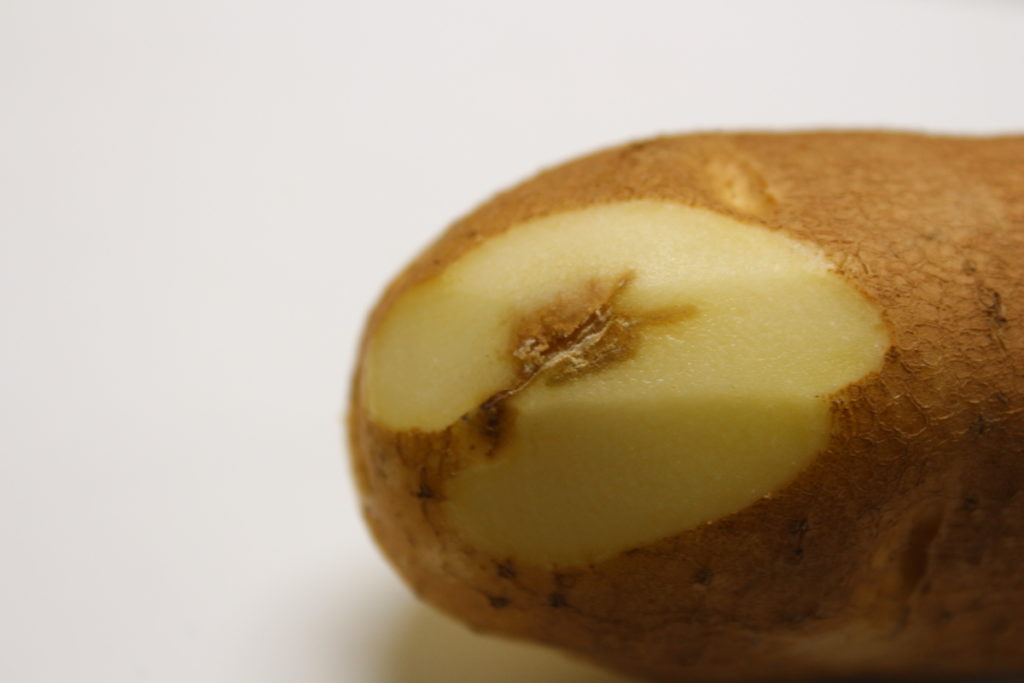
Postharvest quality reduction
Farming is about risk and reward.
One major risk every potato grower must weigh is the likelihood of damaging their crop at harvest and still being able to turn a profit. Millions of potatoes are harvested each fall, and much of the crop is stored up until the following harvest.
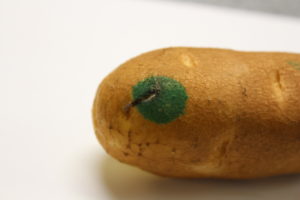
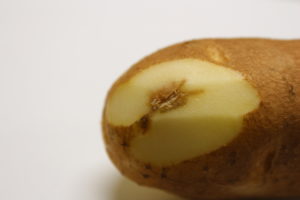
Handling that many potatoes through harvesting, transloading and unloading equipment can inevitably result in potato bruises. To assess the potential of quality reduction in stored potatoes, the University of Idaho developed two studies to help determine the risk associated with blackspot and shatter bruise development and susceptibility to bruising throughout storage. Each study was conducted over two storage seasons.
The objective of the first study was to determine if potatoes bruised at harvest will develop more severe bruises during storage. At harvest, Russet Burbank and Russet Norkotah potatoes (675 potatoes per cultivar; 55°F pulp temperature) were impacted with a device that dropped a 100g steel weight from a 7-inch drop height to deliver uniform impacts on the bud and stem end of each potato.
A subsample was evaluated 24 hours after the impact to provide an initial bruise level at harvest. The remaining impacted tubers were cured at 55°F for two weeks, ramped down at a rate of 0.5°F/day until temperature reached 45°F and stored (95% relative humidity) for the remainder of the study. Each consecutive month until May (eight months in storage), a sub-sample was removed from storage (45°F) and evaluated for bruise development.
Blackspot bruise incidence, severity and depth increased within the first month after harvest, but after the first month, blackspot bruises remained at similar levels for the remainder of time in storage. This was observed for both Russet Burbank and Russet Norkotah.
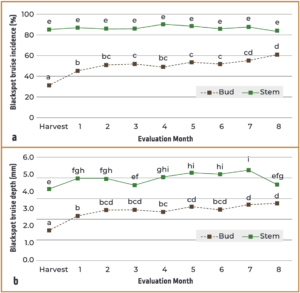
different (α<0.05) for each graph.
Interestingly, the pattern of increase in bruise in the first month of storage was not the same on both ends of the tuber (Figure 1). When bruises were sustained at harvest on the stem end, they did not change in incidence or depth throughout storage. The bud end, however, had a significant increase in blackspot bruise incidence and depth within the first month of storage. Impacts at harvest resulting in shatter bruise did not develop further in storage. Therefore, sub-sampling to determine how much shatter bruise occurred on a commercial operation could be done at harvest.
The objective of the second study was to determine if the risk of bruising potatoes when removed from storage changes with time in storage. For this study, a sub-sample of Russet Burbank and Russet Norkotah potatoes (75 potatoes per cultivar) was impacted at harvest (45°F), then evaluated 24 hours later. The remaining sample of non-bruised potatoes were cured in the same manner as the first trial. Each subsequent month, a sample was removed from storage, impacted at 45°F, held at room temperature (70°F), and evaluated 24 hours later.
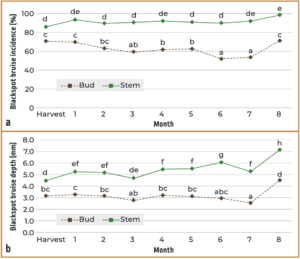
The risk of bruise development associated with handling tubers after unloading from storage was consistent, regardless of the time removed from storage. For blackspot bruise, there was a minor increase from harvest to the eighth month in storage; although, this increase was primarily observed on the stem end of the potato. The bud end had minor fluctuations in blackspot bruise incidence and depth during each month of storage, but by the eighth month susceptibility was similar to tubers impacted at harvest (Figure 2). Even though tuber ends responded differently to impact at different times in storage, overall blackspot bruise susceptibility was consistent throughout storage.
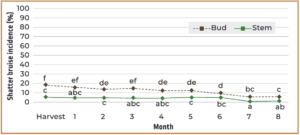
The longer the duration in storage, the less chance of subsequent shatter bruising to occur during handling (Figure 3). Overall, a decrease in shatter bruise incidence was seen by the seventh month in storage. Shatter bruise was routinely accompanied by blackspot bruise throughout this study (data not shown), emphasizing that potatoes impacted during handling may encounter both types of bruises, so understanding the risk for both bruises is beneficial.
Based on these two studies, we can conclude that bruises sustained at harvest do not dramatically change in storage for Russet Burbank and Russet Norkotah. There is a potential for slightly higher blackspot bruise to be observed after storage compared to at harvest. Sub-sampling early in storage would provide a good indication of the bruise level that will be seen through the rest of the storage season.
When removing tubers from storage, the results indicated blackspot bruise susceptibility increased slightly, and shatter bruise susceptibility decreased throughout storage. These fluctuations occurred primarily between early and
late storage, whereas in between, the bulk of the storage season, susceptibility was consistent for both types of bruises. Ensuring there are low levels of bruise going into storage will help reap the rewards throughout the storage season and make the risk worth it.







